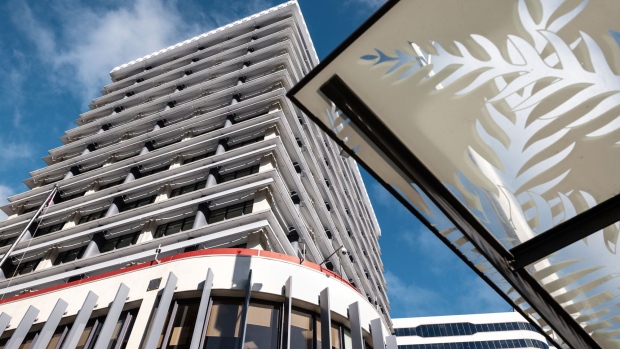Feb 21, 2023
New Zealand Delivers Half-Point Rate Hike, Still Sees 5.5% Peak
, Bloomberg News

(Bloomberg) -- New Zealand’s central bank raised its key interest rate by a half-percentage point, slowing its pace of tightening as borrowing costs reach a level where they begin to weigh on demand in the economy.
The Reserve Bank lifted the Official Cash Rate to 4.75% on Wednesday in Wellington, as predicted by most economists surveyed. It maintained a forecast peak rate of 5.5%, while expecting to take a quarter longer to reach that level.
The downshift from a previous outsized 75 basis-point hike brings the RBNZ closer to global peers that have slowed the pace of tightening as inflation and job markets ease. Still, a half-point move puts it at the upper end of recent increases, with the Federal Reserve switching to a quarter-point this month.
The RBNZ will “further ease the pace of hikes to 25 basis points at the April meeting — alongside further easing in demand pressures and global inflation — before pausing,” Goldman Sachs Group Inc economists led by Andrew Boak said in a research note. Risks are “skewed to a more elongated hiking cycle.”
Traders are pricing in a 40% chance of another half-point increase at the central bank’s April 5 meeting. Others, like Goldman, argue the RBNZ has scope for smaller moves as it has longer to reach the terminal rate.
All options will be on the table, Governor Adrian Orr told reporters.
“We have come a long way and fast,” he said after the decision. “Now that we are confident we are in a restrictive position, we are afforded more time to reflect on whether we’re seeing the outcomes we are hoping to see by now.”
New Zealand is still responding to the shock of Cyclone Gabrielle, which destroyed infrastructure, flooded homes and displaced thousands as it cut across the upper North Island last week. Orchards and food producing regions were devastated, suggesting near-term shortages and price spikes.
The RBNZ said it’s too early to accurately assess the monetary policy implications of the storm.
The Treasury Department said Tuesday the rebuild of homes and infrastructure will add demand to an already capacity constrained construction industry and lead to general, nationwide inflation pressure. That could result in the RBNZ keeping interest rates higher for longer, it said.
The central bank’s updated forecasts were little changed from those it presented in November. They show the OCR rising to 5.5% in the fourth quarter of 2023, then gradually declining from the third quarter of 2024.
What Bloomberg Economics Says...
“Deterioration in the global and domestic economies, together with easing global inflation, are likely to prompt the RBNZ to soften its hawkish stance and reverse course, potentially as soon as late 2023”
—James McIntyre, economist.
To read the full note, click here
The RBNZ reiterated that it expects the economy to enter recession in the second quarter of this year, but then to bounce back to growth a little earlier next year.
Inflation will be slightly firmer than previously expected through the second half of 2023, the RBNZ’s new projections showed.
Consumer-price growth will return to the top of the central bank’s 1-3% target by the third quarter of 2024, unchanged from the previous forecast.
--With assistance from Swati Pandey.
(Updates with comment from economist.)
©2023 Bloomberg L.P.






